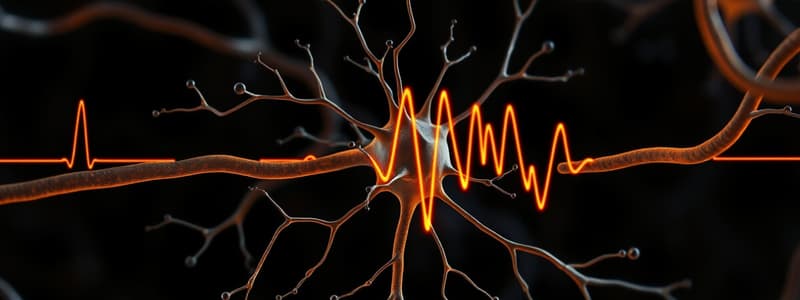Podcast
Questions and Answers
What is the typical range of resting potential in a neuron?
What is the typical range of resting potential in a neuron?
- -70 mV to -80 mV
- -40 mV to -50 mV
- -60 mV to -70 mV (correct)
- -50 mV to -60 mV
What role does the sodium-potassium pump play in resting potential?
What role does the sodium-potassium pump play in resting potential?
- It transports Na+ ions into and K+ ions out of the cell.
- It facilitates the passive diffusion of K+ ions into the cell.
- It actively maintains the negative charge inside the neuron. (correct)
- It transports 2 Na+ ions in and 3 K+ ions out of the cell.
How does changes in resting potential affect neuronal excitability?
How does changes in resting potential affect neuronal excitability?
- It has no effect on neuronal excitability.
- It decreases the threshold for action potential initiation.
- It may influence cognitive functions, mood, and behavior. (correct)
- It enhances the ability to respond to signals optimally.
Which ions have a higher concentration outside the neuron at resting potential?
Which ions have a higher concentration outside the neuron at resting potential?
What initiates an action potential in a neuron?
What initiates an action potential in a neuron?
What is one consequence of maintaining resting potential?
What is one consequence of maintaining resting potential?
What is the primary mechanism contributing to the negativity inside the neuron?
What is the primary mechanism contributing to the negativity inside the neuron?
Which disorder may be linked to abnormal resting potentials?
Which disorder may be linked to abnormal resting potentials?
Flashcards are hidden until you start studying
Study Notes
Resting Potential
- Definition: The resting potential is the electrical charge difference across the membrane of a neuron when it is not actively transmitting a signal.
- Typical Value: Ranges from -60 mV to -70 mV inside the neuron relative to the outside environment.
- Ion Distribution:
- Higher concentration of K+ (potassium) ions inside the cell.
- Higher concentration of Na+ (sodium) ions outside the cell.
- Mechanisms:
- Sodium-Potassium Pump: Actively transports 3 Na+ ions out of the cell and 2 K+ ions into the cell, contributing to the negative charge inside.
- Potassium Leak Channels: Allow K+ ions to move out of the cell, further increasing negativity.
Role in Neuronal Activity
- Action Potential Generation: The resting potential is crucial for the initiation of action potentials, which are rapid changes in membrane potential that propagate signals along neurons.
- Threshold Potential: When depolarization occurs (e.g., due to Na+ influx), if the membrane potential reaches a certain threshold, an action potential is triggered.
Brain Function and Resting Potential
- Neural Communication: The resting potential establishes the conditions necessary for the transmission of signals between neurons in the brain.
- Influence on Brain Activity:
- Changes in resting potential can affect excitability of neurons, influencing cognitive functions, mood, and behavior.
- Disorders such as epilepsy may be linked to abnormal resting potentials.
Importance of Maintaining Resting Potential
- Homeostasis: Essential for maintaining the overall balance of ions and ensuring neurons are ready to respond to stimuli.
- Neurotransmitter Release: Proper resting potential is crucial for the release of neurotransmitters at synapses, facilitating communication between neurons.
- Energy Consumption: The maintenance of resting potential involves energy (ATP) expenditure, mainly due to the sodium-potassium pump.
Resting Potential
- The resting potential is the electrical charge difference across a neuron's membrane when not transmitting signals.
- Typical resting potential values are between -60 mV and -70 mV inside the neuron.
- There is a higher concentration of potassium (K+) ions inside the neuron and sodium (Na+) ions outside.
- The sodium-potassium pump actively transports three Na+ ions out of the neuron and two K+ ions in, contributing to the negative charge.
- Potassium leak channels allow K+ ions to exit the neuron, increasing the interior negativity further.
Role in Neuronal Activity
- Resting potential is crucial for initiating action potentials, which are rapid membrane potential changes that signal propagation in neurons.
- If membrane depolarization reaches a specific threshold (often due to Na+ influx), an action potential is generated.
Brain Function and Resting Potential
- The resting potential is vital for establishing the conditions needed for neural communication.
- Variations in resting potential can influence neuronal excitability and impact cognitive functions, mood, and behavior.
- Disorders like epilepsy may arise from irregular resting potenials, affecting neuronal stability.
Importance of Maintaining Resting Potential
- Maintaining resting potential is essential for ion balance and allows neurons to respond promptly to stimuli.
- A proper resting potential is necessary for neurotransmitter release at synapses, ensuring effective neuron communication.
- Maintenance of resting potential requires energy expenditure (ATP), primarily driven by the operation of the sodium-potassium pump.
Studying That Suits You
Use AI to generate personalized quizzes and flashcards to suit your learning preferences.




